Aviation Safety Management System: Regulations, Future Needs Analysis
VerifiedAdded on 2022/08/24
|11
|2996
|14
Report
AI Summary
This report provides a comprehensive analysis of Aviation Safety Management Systems (SMS). It begins by examining the role of international organizations like ICAO and their efforts to enhance safety through coordination, standardization, and proactive risk-based solutions. The report delves into the Global Aviation Safety Program (GASP) and its objectives, initiatives, and contribution to reducing global accidents. It also discusses the importance of safety management culture and the implementation of safety initiatives. The analysis further explores the role of regulatory bodies like the FAA and the IATA, and how they contribute to safety improvements. The report then shifts to the future needs of the aviation industry, including the importance of runway safety and the need for continuous development of safety measures. It highlights the contributions of aircraft manufacturers like Airbus and Boeing to aviation safety programs. The report concludes by emphasizing the need for corporate responsibility, transparency, and the monitoring of customer attitudes in a competitive market. Overall, the report provides a detailed overview of the complexities and challenges in aviation safety, as well as the ongoing efforts to ensure a safe and efficient global air transport system.
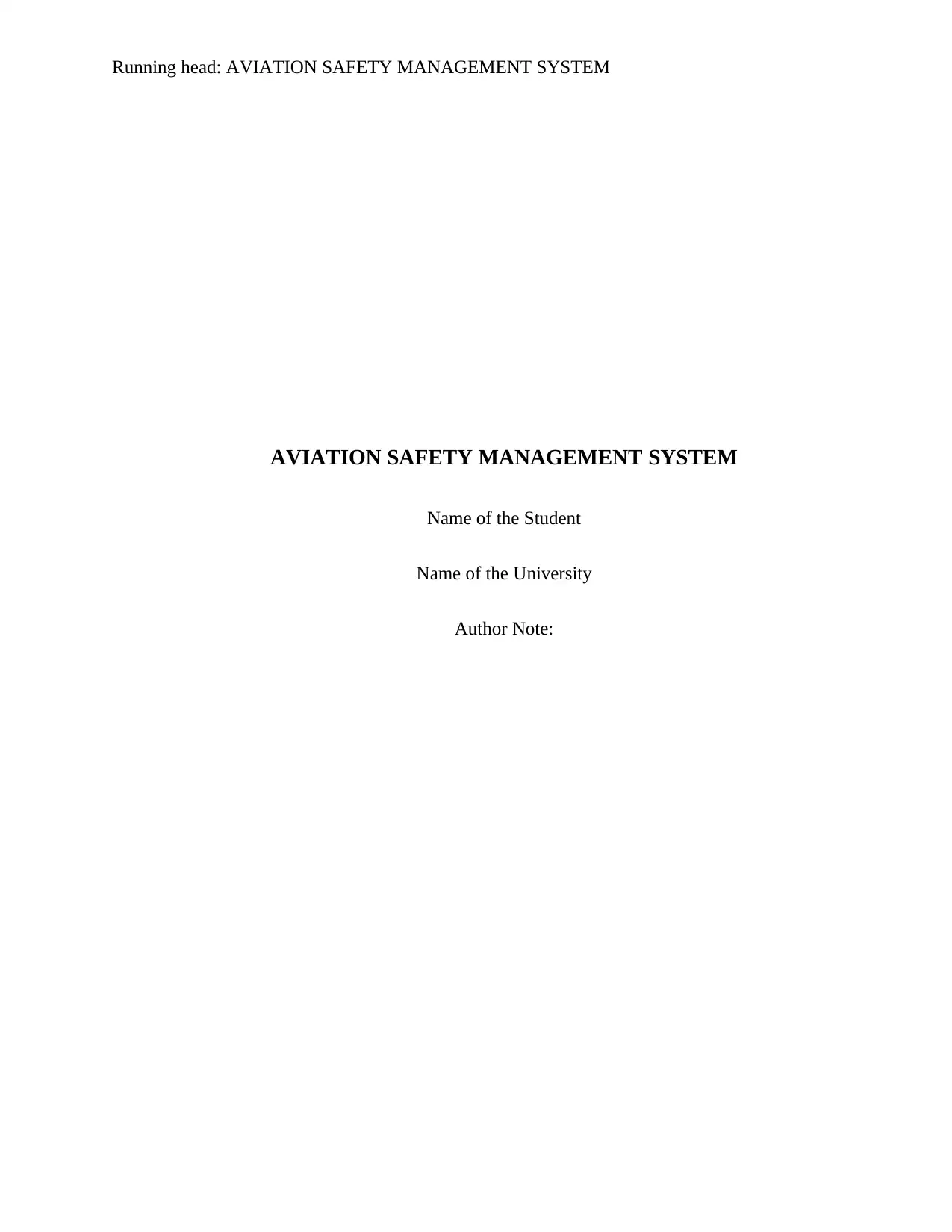
Running head: AVIATION SAFETY MANAGEMENT SYSTEM
AVIATION SAFETY MANAGEMENT SYSTEM
Name of the Student
Name of the University
Author Note:
AVIATION SAFETY MANAGEMENT SYSTEM
Name of the Student
Name of the University
Author Note:
Paraphrase This Document
Need a fresh take? Get an instant paraphrase of this document with our AI Paraphraser
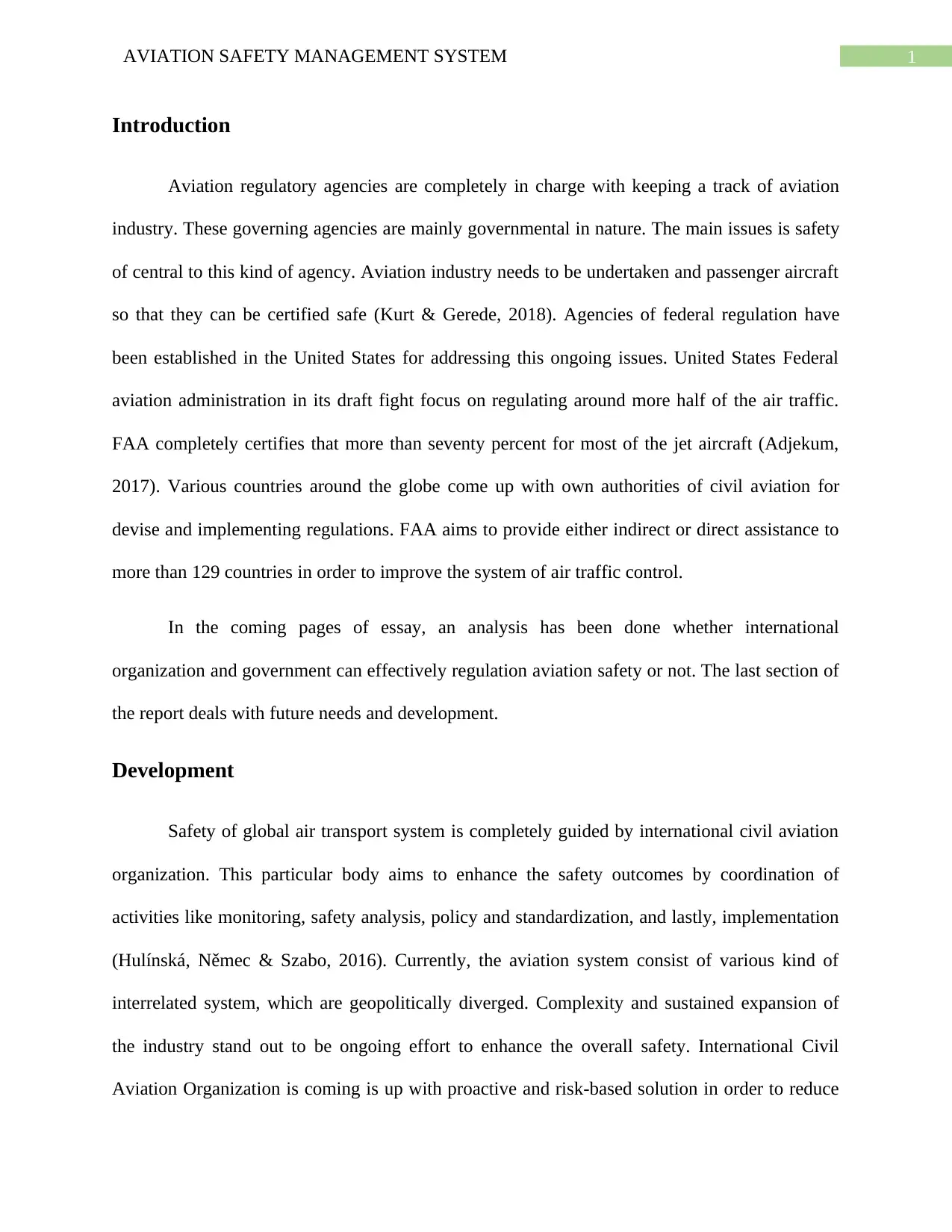
1AVIATION SAFETY MANAGEMENT SYSTEM
Introduction
Aviation regulatory agencies are completely in charge with keeping a track of aviation
industry. These governing agencies are mainly governmental in nature. The main issues is safety
of central to this kind of agency. Aviation industry needs to be undertaken and passenger aircraft
so that they can be certified safe (Kurt & Gerede, 2018). Agencies of federal regulation have
been established in the United States for addressing this ongoing issues. United States Federal
aviation administration in its draft fight focus on regulating around more half of the air traffic.
FAA completely certifies that more than seventy percent for most of the jet aircraft (Adjekum,
2017). Various countries around the globe come up with own authorities of civil aviation for
devise and implementing regulations. FAA aims to provide either indirect or direct assistance to
more than 129 countries in order to improve the system of air traffic control.
In the coming pages of essay, an analysis has been done whether international
organization and government can effectively regulation aviation safety or not. The last section of
the report deals with future needs and development.
Development
Safety of global air transport system is completely guided by international civil aviation
organization. This particular body aims to enhance the safety outcomes by coordination of
activities like monitoring, safety analysis, policy and standardization, and lastly, implementation
(Hulínská, Němec & Szabo, 2016). Currently, the aviation system consist of various kind of
interrelated system, which are geopolitically diverged. Complexity and sustained expansion of
the industry stand out to be ongoing effort to enhance the overall safety. International Civil
Aviation Organization is coming is up with proactive and risk-based solution in order to reduce
Introduction
Aviation regulatory agencies are completely in charge with keeping a track of aviation
industry. These governing agencies are mainly governmental in nature. The main issues is safety
of central to this kind of agency. Aviation industry needs to be undertaken and passenger aircraft
so that they can be certified safe (Kurt & Gerede, 2018). Agencies of federal regulation have
been established in the United States for addressing this ongoing issues. United States Federal
aviation administration in its draft fight focus on regulating around more half of the air traffic.
FAA completely certifies that more than seventy percent for most of the jet aircraft (Adjekum,
2017). Various countries around the globe come up with own authorities of civil aviation for
devise and implementing regulations. FAA aims to provide either indirect or direct assistance to
more than 129 countries in order to improve the system of air traffic control.
In the coming pages of essay, an analysis has been done whether international
organization and government can effectively regulation aviation safety or not. The last section of
the report deals with future needs and development.
Development
Safety of global air transport system is completely guided by international civil aviation
organization. This particular body aims to enhance the safety outcomes by coordination of
activities like monitoring, safety analysis, policy and standardization, and lastly, implementation
(Hulínská, Němec & Szabo, 2016). Currently, the aviation system consist of various kind of
interrelated system, which are geopolitically diverged. Complexity and sustained expansion of
the industry stand out to be ongoing effort to enhance the overall safety. International Civil
Aviation Organization is coming is up with proactive and risk-based solution in order to reduce
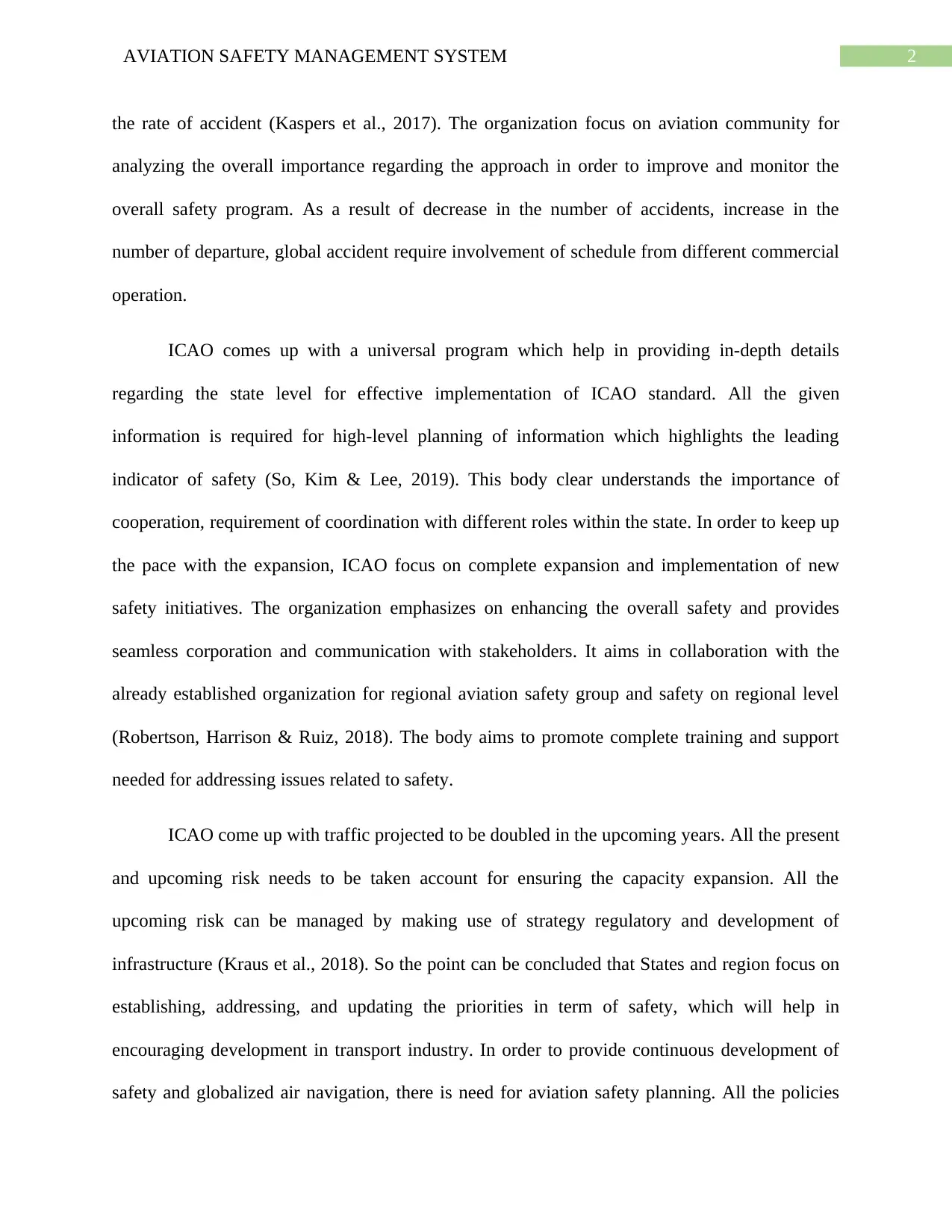
2AVIATION SAFETY MANAGEMENT SYSTEM
the rate of accident (Kaspers et al., 2017). The organization focus on aviation community for
analyzing the overall importance regarding the approach in order to improve and monitor the
overall safety program. As a result of decrease in the number of accidents, increase in the
number of departure, global accident require involvement of schedule from different commercial
operation.
ICAO comes up with a universal program which help in providing in-depth details
regarding the state level for effective implementation of ICAO standard. All the given
information is required for high-level planning of information which highlights the leading
indicator of safety (So, Kim & Lee, 2019). This body clear understands the importance of
cooperation, requirement of coordination with different roles within the state. In order to keep up
the pace with the expansion, ICAO focus on complete expansion and implementation of new
safety initiatives. The organization emphasizes on enhancing the overall safety and provides
seamless corporation and communication with stakeholders. It aims in collaboration with the
already established organization for regional aviation safety group and safety on regional level
(Robertson, Harrison & Ruiz, 2018). The body aims to promote complete training and support
needed for addressing issues related to safety.
ICAO come up with traffic projected to be doubled in the upcoming years. All the present
and upcoming risk needs to be taken account for ensuring the capacity expansion. All the
upcoming risk can be managed by making use of strategy regulatory and development of
infrastructure (Kraus et al., 2018). So the point can be concluded that States and region focus on
establishing, addressing, and updating the priorities in term of safety, which will help in
encouraging development in transport industry. In order to provide continuous development of
safety and globalized air navigation, there is need for aviation safety planning. All the policies
the rate of accident (Kaspers et al., 2017). The organization focus on aviation community for
analyzing the overall importance regarding the approach in order to improve and monitor the
overall safety program. As a result of decrease in the number of accidents, increase in the
number of departure, global accident require involvement of schedule from different commercial
operation.
ICAO comes up with a universal program which help in providing in-depth details
regarding the state level for effective implementation of ICAO standard. All the given
information is required for high-level planning of information which highlights the leading
indicator of safety (So, Kim & Lee, 2019). This body clear understands the importance of
cooperation, requirement of coordination with different roles within the state. In order to keep up
the pace with the expansion, ICAO focus on complete expansion and implementation of new
safety initiatives. The organization emphasizes on enhancing the overall safety and provides
seamless corporation and communication with stakeholders. It aims in collaboration with the
already established organization for regional aviation safety group and safety on regional level
(Robertson, Harrison & Ruiz, 2018). The body aims to promote complete training and support
needed for addressing issues related to safety.
ICAO come up with traffic projected to be doubled in the upcoming years. All the present
and upcoming risk needs to be taken account for ensuring the capacity expansion. All the
upcoming risk can be managed by making use of strategy regulatory and development of
infrastructure (Kraus et al., 2018). So the point can be concluded that States and region focus on
establishing, addressing, and updating the priorities in term of safety, which will help in
encouraging development in transport industry. In order to provide continuous development of
safety and globalized air navigation, there is need for aviation safety planning. All the policies
⊘ This is a preview!⊘
Do you want full access?
Subscribe today to unlock all pages.

Trusted by 1+ million students worldwide
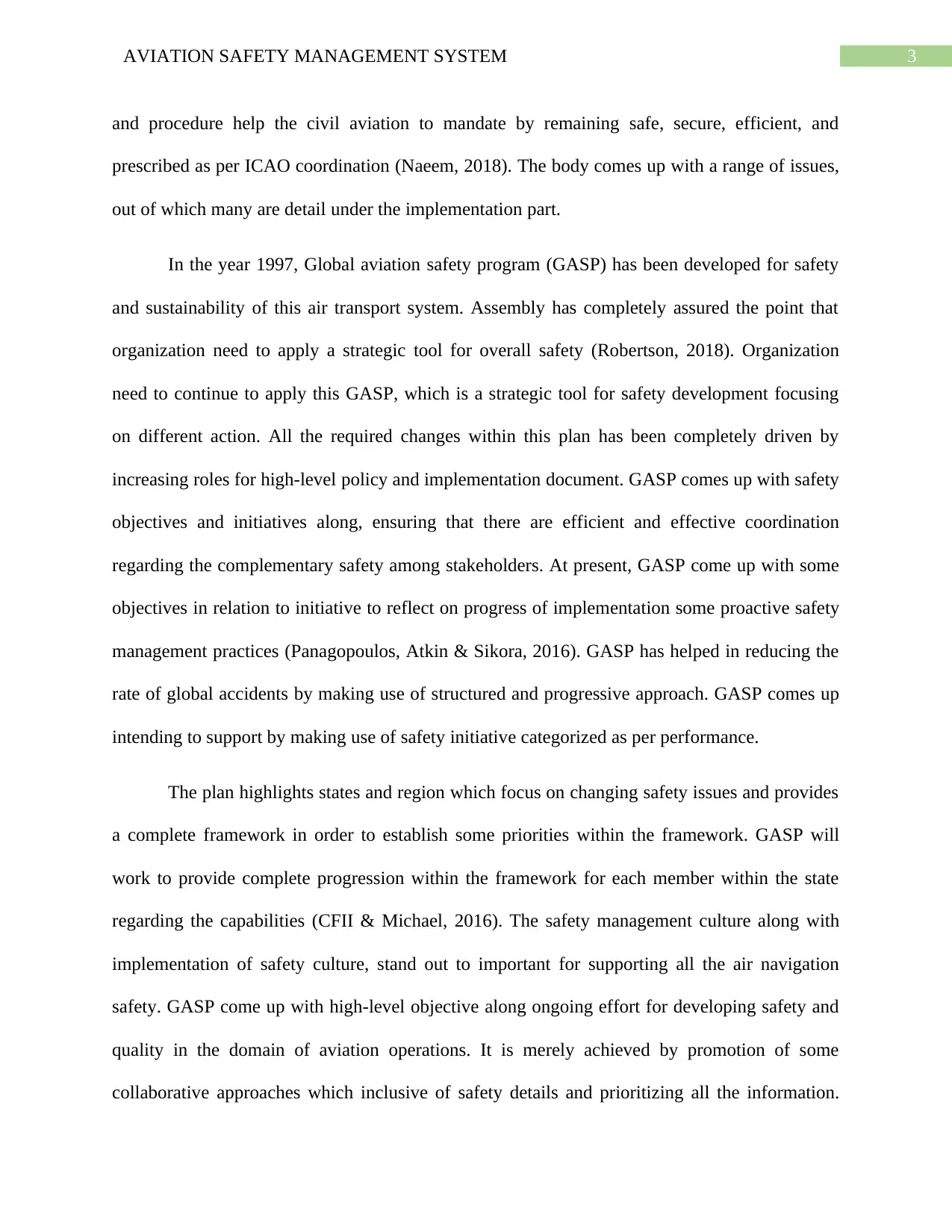
3AVIATION SAFETY MANAGEMENT SYSTEM
and procedure help the civil aviation to mandate by remaining safe, secure, efficient, and
prescribed as per ICAO coordination (Naeem, 2018). The body comes up with a range of issues,
out of which many are detail under the implementation part.
In the year 1997, Global aviation safety program (GASP) has been developed for safety
and sustainability of this air transport system. Assembly has completely assured the point that
organization need to apply a strategic tool for overall safety (Robertson, 2018). Organization
need to continue to apply this GASP, which is a strategic tool for safety development focusing
on different action. All the required changes within this plan has been completely driven by
increasing roles for high-level policy and implementation document. GASP comes up with safety
objectives and initiatives along, ensuring that there are efficient and effective coordination
regarding the complementary safety among stakeholders. At present, GASP come up with some
objectives in relation to initiative to reflect on progress of implementation some proactive safety
management practices (Panagopoulos, Atkin & Sikora, 2016). GASP has helped in reducing the
rate of global accidents by making use of structured and progressive approach. GASP comes up
intending to support by making use of safety initiative categorized as per performance.
The plan highlights states and region which focus on changing safety issues and provides
a complete framework in order to establish some priorities within the framework. GASP will
work to provide complete progression within the framework for each member within the state
regarding the capabilities (CFII & Michael, 2016). The safety management culture along with
implementation of safety culture, stand out to important for supporting all the air navigation
safety. GASP come up with high-level objective along ongoing effort for developing safety and
quality in the domain of aviation operations. It is merely achieved by promotion of some
collaborative approaches which inclusive of safety details and prioritizing all the information.
and procedure help the civil aviation to mandate by remaining safe, secure, efficient, and
prescribed as per ICAO coordination (Naeem, 2018). The body comes up with a range of issues,
out of which many are detail under the implementation part.
In the year 1997, Global aviation safety program (GASP) has been developed for safety
and sustainability of this air transport system. Assembly has completely assured the point that
organization need to apply a strategic tool for overall safety (Robertson, 2018). Organization
need to continue to apply this GASP, which is a strategic tool for safety development focusing
on different action. All the required changes within this plan has been completely driven by
increasing roles for high-level policy and implementation document. GASP comes up with safety
objectives and initiatives along, ensuring that there are efficient and effective coordination
regarding the complementary safety among stakeholders. At present, GASP come up with some
objectives in relation to initiative to reflect on progress of implementation some proactive safety
management practices (Panagopoulos, Atkin & Sikora, 2016). GASP has helped in reducing the
rate of global accidents by making use of structured and progressive approach. GASP comes up
intending to support by making use of safety initiative categorized as per performance.
The plan highlights states and region which focus on changing safety issues and provides
a complete framework in order to establish some priorities within the framework. GASP will
work to provide complete progression within the framework for each member within the state
regarding the capabilities (CFII & Michael, 2016). The safety management culture along with
implementation of safety culture, stand out to important for supporting all the air navigation
safety. GASP come up with high-level objective along ongoing effort for developing safety and
quality in the domain of aviation operations. It is merely achieved by promotion of some
collaborative approaches which inclusive of safety details and prioritizing all the information.
Paraphrase This Document
Need a fresh take? Get an instant paraphrase of this document with our AI Paraphraser
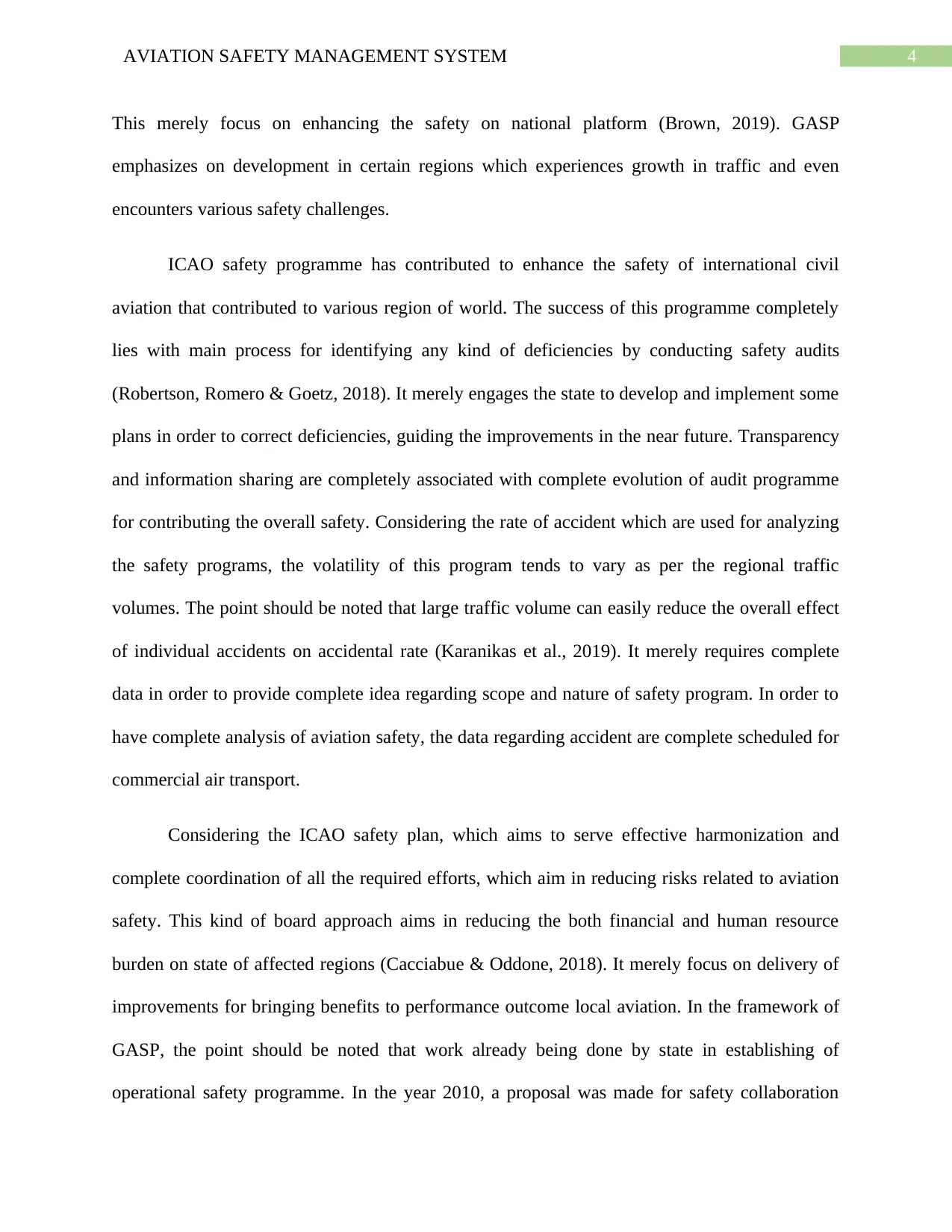
4AVIATION SAFETY MANAGEMENT SYSTEM
This merely focus on enhancing the safety on national platform (Brown, 2019). GASP
emphasizes on development in certain regions which experiences growth in traffic and even
encounters various safety challenges.
ICAO safety programme has contributed to enhance the safety of international civil
aviation that contributed to various region of world. The success of this programme completely
lies with main process for identifying any kind of deficiencies by conducting safety audits
(Robertson, Romero & Goetz, 2018). It merely engages the state to develop and implement some
plans in order to correct deficiencies, guiding the improvements in the near future. Transparency
and information sharing are completely associated with complete evolution of audit programme
for contributing the overall safety. Considering the rate of accident which are used for analyzing
the safety programs, the volatility of this program tends to vary as per the regional traffic
volumes. The point should be noted that large traffic volume can easily reduce the overall effect
of individual accidents on accidental rate (Karanikas et al., 2019). It merely requires complete
data in order to provide complete idea regarding scope and nature of safety program. In order to
have complete analysis of aviation safety, the data regarding accident are complete scheduled for
commercial air transport.
Considering the ICAO safety plan, which aims to serve effective harmonization and
complete coordination of all the required efforts, which aim in reducing risks related to aviation
safety. This kind of board approach aims in reducing the both financial and human resource
burden on state of affected regions (Cacciabue & Oddone, 2018). It merely focus on delivery of
improvements for bringing benefits to performance outcome local aviation. In the framework of
GASP, the point should be noted that work already being done by state in establishing of
operational safety programme. In the year 2010, a proposal was made for safety collaboration
This merely focus on enhancing the safety on national platform (Brown, 2019). GASP
emphasizes on development in certain regions which experiences growth in traffic and even
encounters various safety challenges.
ICAO safety programme has contributed to enhance the safety of international civil
aviation that contributed to various region of world. The success of this programme completely
lies with main process for identifying any kind of deficiencies by conducting safety audits
(Robertson, Romero & Goetz, 2018). It merely engages the state to develop and implement some
plans in order to correct deficiencies, guiding the improvements in the near future. Transparency
and information sharing are completely associated with complete evolution of audit programme
for contributing the overall safety. Considering the rate of accident which are used for analyzing
the safety programs, the volatility of this program tends to vary as per the regional traffic
volumes. The point should be noted that large traffic volume can easily reduce the overall effect
of individual accidents on accidental rate (Karanikas et al., 2019). It merely requires complete
data in order to provide complete idea regarding scope and nature of safety program. In order to
have complete analysis of aviation safety, the data regarding accident are complete scheduled for
commercial air transport.
Considering the ICAO safety plan, which aims to serve effective harmonization and
complete coordination of all the required efforts, which aim in reducing risks related to aviation
safety. This kind of board approach aims in reducing the both financial and human resource
burden on state of affected regions (Cacciabue & Oddone, 2018). It merely focus on delivery of
improvements for bringing benefits to performance outcome local aviation. In the framework of
GASP, the point should be noted that work already being done by state in establishing of
operational safety programme. In the year 2010, a proposal was made for safety collaboration
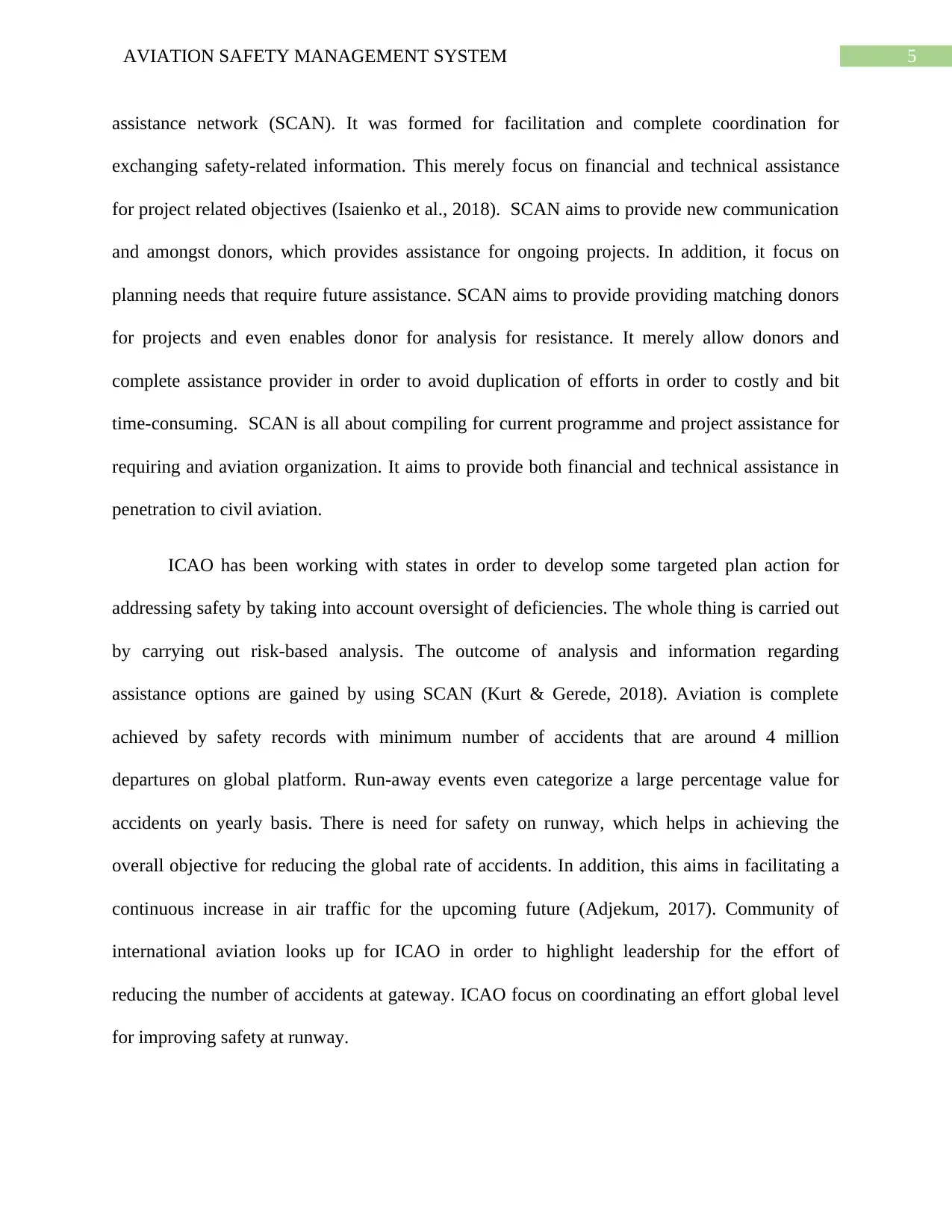
5AVIATION SAFETY MANAGEMENT SYSTEM
assistance network (SCAN). It was formed for facilitation and complete coordination for
exchanging safety-related information. This merely focus on financial and technical assistance
for project related objectives (Isaienko et al., 2018). SCAN aims to provide new communication
and amongst donors, which provides assistance for ongoing projects. In addition, it focus on
planning needs that require future assistance. SCAN aims to provide providing matching donors
for projects and even enables donor for analysis for resistance. It merely allow donors and
complete assistance provider in order to avoid duplication of efforts in order to costly and bit
time-consuming. SCAN is all about compiling for current programme and project assistance for
requiring and aviation organization. It aims to provide both financial and technical assistance in
penetration to civil aviation.
ICAO has been working with states in order to develop some targeted plan action for
addressing safety by taking into account oversight of deficiencies. The whole thing is carried out
by carrying out risk-based analysis. The outcome of analysis and information regarding
assistance options are gained by using SCAN (Kurt & Gerede, 2018). Aviation is complete
achieved by safety records with minimum number of accidents that are around 4 million
departures on global platform. Run-away events even categorize a large percentage value for
accidents on yearly basis. There is need for safety on runway, which helps in achieving the
overall objective for reducing the global rate of accidents. In addition, this aims in facilitating a
continuous increase in air traffic for the upcoming future (Adjekum, 2017). Community of
international aviation looks up for ICAO in order to highlight leadership for the effort of
reducing the number of accidents at gateway. ICAO focus on coordinating an effort global level
for improving safety at runway.
assistance network (SCAN). It was formed for facilitation and complete coordination for
exchanging safety-related information. This merely focus on financial and technical assistance
for project related objectives (Isaienko et al., 2018). SCAN aims to provide new communication
and amongst donors, which provides assistance for ongoing projects. In addition, it focus on
planning needs that require future assistance. SCAN aims to provide providing matching donors
for projects and even enables donor for analysis for resistance. It merely allow donors and
complete assistance provider in order to avoid duplication of efforts in order to costly and bit
time-consuming. SCAN is all about compiling for current programme and project assistance for
requiring and aviation organization. It aims to provide both financial and technical assistance in
penetration to civil aviation.
ICAO has been working with states in order to develop some targeted plan action for
addressing safety by taking into account oversight of deficiencies. The whole thing is carried out
by carrying out risk-based analysis. The outcome of analysis and information regarding
assistance options are gained by using SCAN (Kurt & Gerede, 2018). Aviation is complete
achieved by safety records with minimum number of accidents that are around 4 million
departures on global platform. Run-away events even categorize a large percentage value for
accidents on yearly basis. There is need for safety on runway, which helps in achieving the
overall objective for reducing the global rate of accidents. In addition, this aims in facilitating a
continuous increase in air traffic for the upcoming future (Adjekum, 2017). Community of
international aviation looks up for ICAO in order to highlight leadership for the effort of
reducing the number of accidents at gateway. ICAO focus on coordinating an effort global level
for improving safety at runway.
⊘ This is a preview!⊘
Do you want full access?
Subscribe today to unlock all pages.

Trusted by 1+ million students worldwide
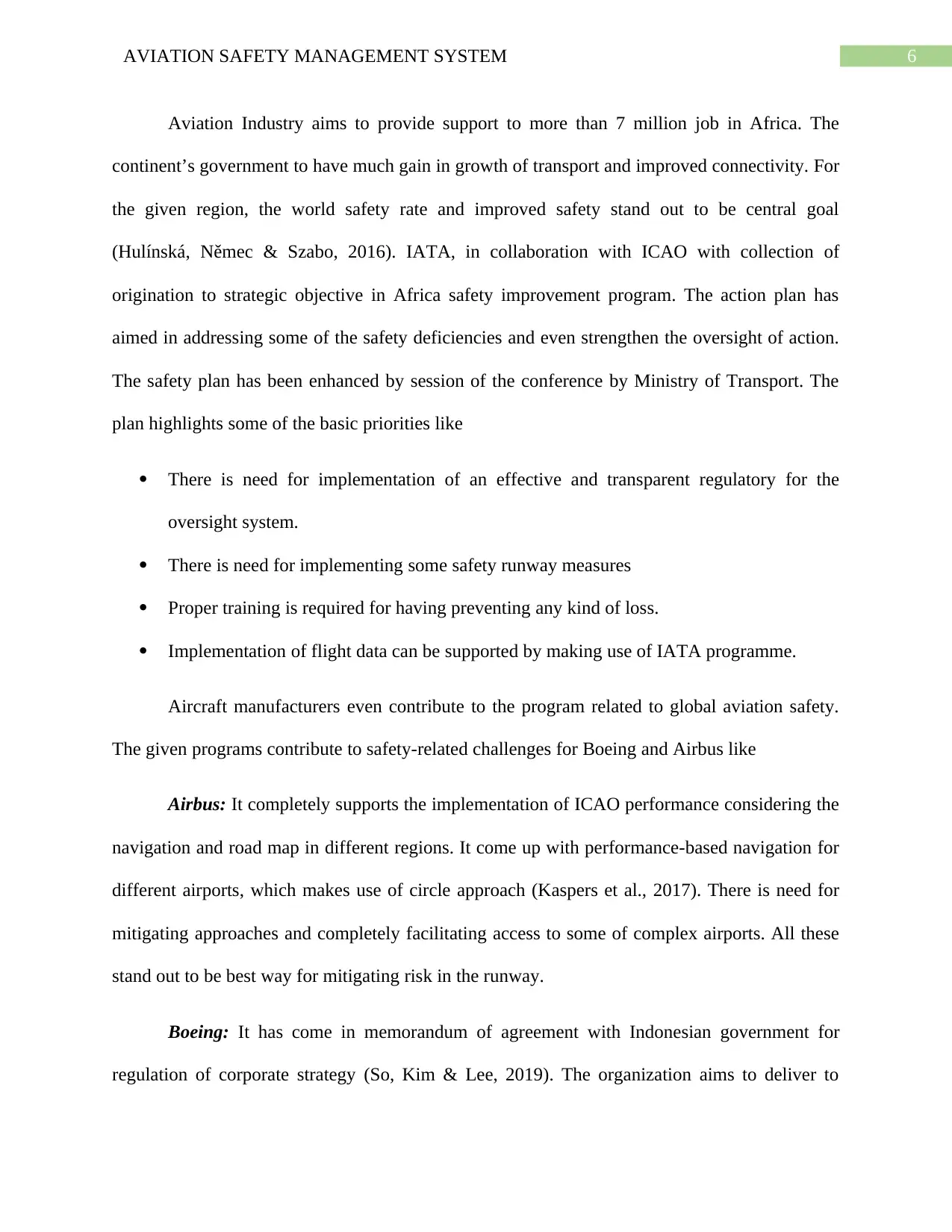
6AVIATION SAFETY MANAGEMENT SYSTEM
Aviation Industry aims to provide support to more than 7 million job in Africa. The
continent’s government to have much gain in growth of transport and improved connectivity. For
the given region, the world safety rate and improved safety stand out to be central goal
(Hulínská, Němec & Szabo, 2016). IATA, in collaboration with ICAO with collection of
origination to strategic objective in Africa safety improvement program. The action plan has
aimed in addressing some of the safety deficiencies and even strengthen the oversight of action.
The safety plan has been enhanced by session of the conference by Ministry of Transport. The
plan highlights some of the basic priorities like
There is need for implementation of an effective and transparent regulatory for the
oversight system.
There is need for implementing some safety runway measures
Proper training is required for having preventing any kind of loss.
Implementation of flight data can be supported by making use of IATA programme.
Aircraft manufacturers even contribute to the program related to global aviation safety.
The given programs contribute to safety-related challenges for Boeing and Airbus like
Airbus: It completely supports the implementation of ICAO performance considering the
navigation and road map in different regions. It come up with performance-based navigation for
different airports, which makes use of circle approach (Kaspers et al., 2017). There is need for
mitigating approaches and completely facilitating access to some of complex airports. All these
stand out to be best way for mitigating risk in the runway.
Boeing: It has come in memorandum of agreement with Indonesian government for
regulation of corporate strategy (So, Kim & Lee, 2019). The organization aims to deliver to
Aviation Industry aims to provide support to more than 7 million job in Africa. The
continent’s government to have much gain in growth of transport and improved connectivity. For
the given region, the world safety rate and improved safety stand out to be central goal
(Hulínská, Němec & Szabo, 2016). IATA, in collaboration with ICAO with collection of
origination to strategic objective in Africa safety improvement program. The action plan has
aimed in addressing some of the safety deficiencies and even strengthen the oversight of action.
The safety plan has been enhanced by session of the conference by Ministry of Transport. The
plan highlights some of the basic priorities like
There is need for implementation of an effective and transparent regulatory for the
oversight system.
There is need for implementing some safety runway measures
Proper training is required for having preventing any kind of loss.
Implementation of flight data can be supported by making use of IATA programme.
Aircraft manufacturers even contribute to the program related to global aviation safety.
The given programs contribute to safety-related challenges for Boeing and Airbus like
Airbus: It completely supports the implementation of ICAO performance considering the
navigation and road map in different regions. It come up with performance-based navigation for
different airports, which makes use of circle approach (Kaspers et al., 2017). There is need for
mitigating approaches and completely facilitating access to some of complex airports. All these
stand out to be best way for mitigating risk in the runway.
Boeing: It has come in memorandum of agreement with Indonesian government for
regulation of corporate strategy (So, Kim & Lee, 2019). The organization aims to deliver to
Paraphrase This Document
Need a fresh take? Get an instant paraphrase of this document with our AI Paraphraser
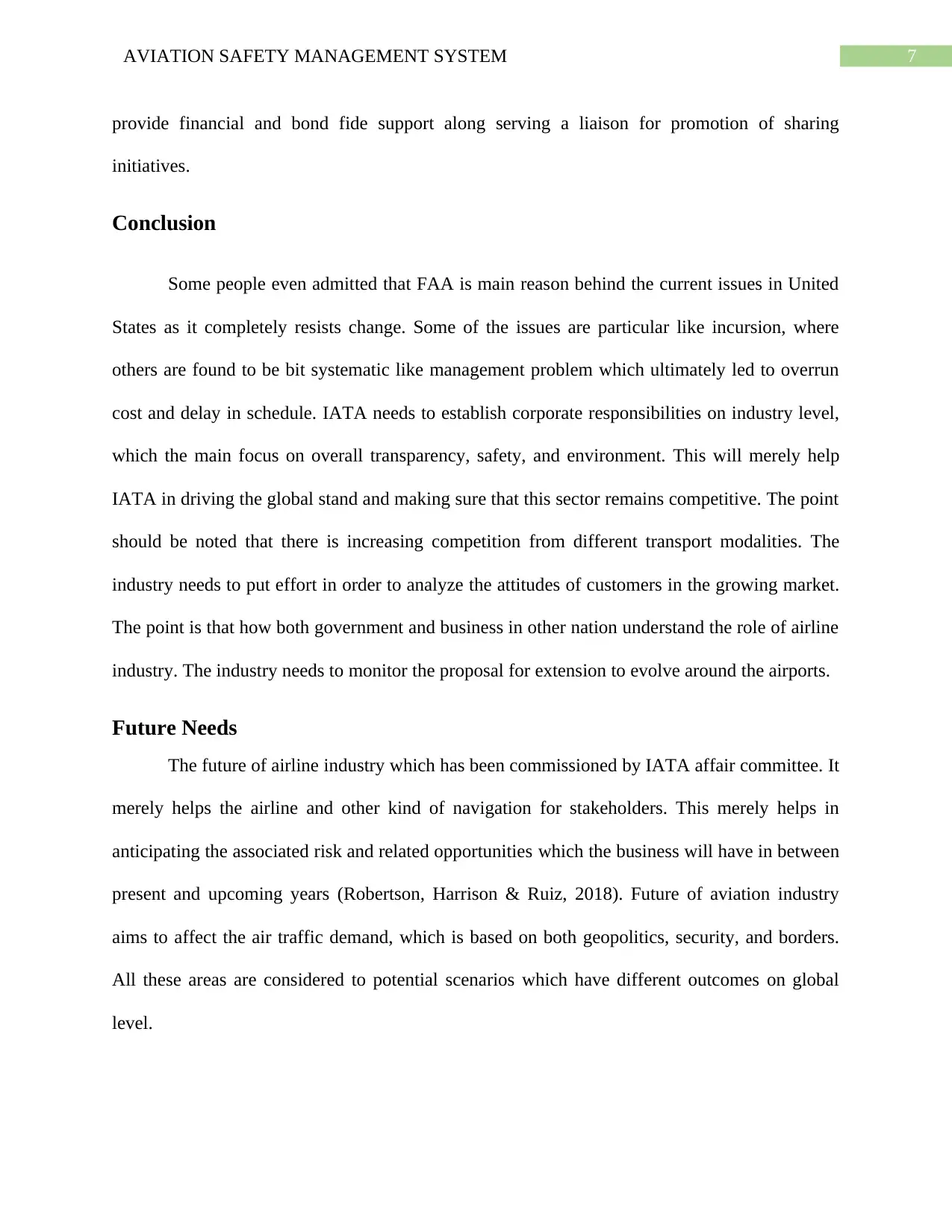
7AVIATION SAFETY MANAGEMENT SYSTEM
provide financial and bond fide support along serving a liaison for promotion of sharing
initiatives.
Conclusion
Some people even admitted that FAA is main reason behind the current issues in United
States as it completely resists change. Some of the issues are particular like incursion, where
others are found to be bit systematic like management problem which ultimately led to overrun
cost and delay in schedule. IATA needs to establish corporate responsibilities on industry level,
which the main focus on overall transparency, safety, and environment. This will merely help
IATA in driving the global stand and making sure that this sector remains competitive. The point
should be noted that there is increasing competition from different transport modalities. The
industry needs to put effort in order to analyze the attitudes of customers in the growing market.
The point is that how both government and business in other nation understand the role of airline
industry. The industry needs to monitor the proposal for extension to evolve around the airports.
Future Needs
The future of airline industry which has been commissioned by IATA affair committee. It
merely helps the airline and other kind of navigation for stakeholders. This merely helps in
anticipating the associated risk and related opportunities which the business will have in between
present and upcoming years (Robertson, Harrison & Ruiz, 2018). Future of aviation industry
aims to affect the air traffic demand, which is based on both geopolitics, security, and borders.
All these areas are considered to potential scenarios which have different outcomes on global
level.
provide financial and bond fide support along serving a liaison for promotion of sharing
initiatives.
Conclusion
Some people even admitted that FAA is main reason behind the current issues in United
States as it completely resists change. Some of the issues are particular like incursion, where
others are found to be bit systematic like management problem which ultimately led to overrun
cost and delay in schedule. IATA needs to establish corporate responsibilities on industry level,
which the main focus on overall transparency, safety, and environment. This will merely help
IATA in driving the global stand and making sure that this sector remains competitive. The point
should be noted that there is increasing competition from different transport modalities. The
industry needs to put effort in order to analyze the attitudes of customers in the growing market.
The point is that how both government and business in other nation understand the role of airline
industry. The industry needs to monitor the proposal for extension to evolve around the airports.
Future Needs
The future of airline industry which has been commissioned by IATA affair committee. It
merely helps the airline and other kind of navigation for stakeholders. This merely helps in
anticipating the associated risk and related opportunities which the business will have in between
present and upcoming years (Robertson, Harrison & Ruiz, 2018). Future of aviation industry
aims to affect the air traffic demand, which is based on both geopolitics, security, and borders.
All these areas are considered to potential scenarios which have different outcomes on global
level.
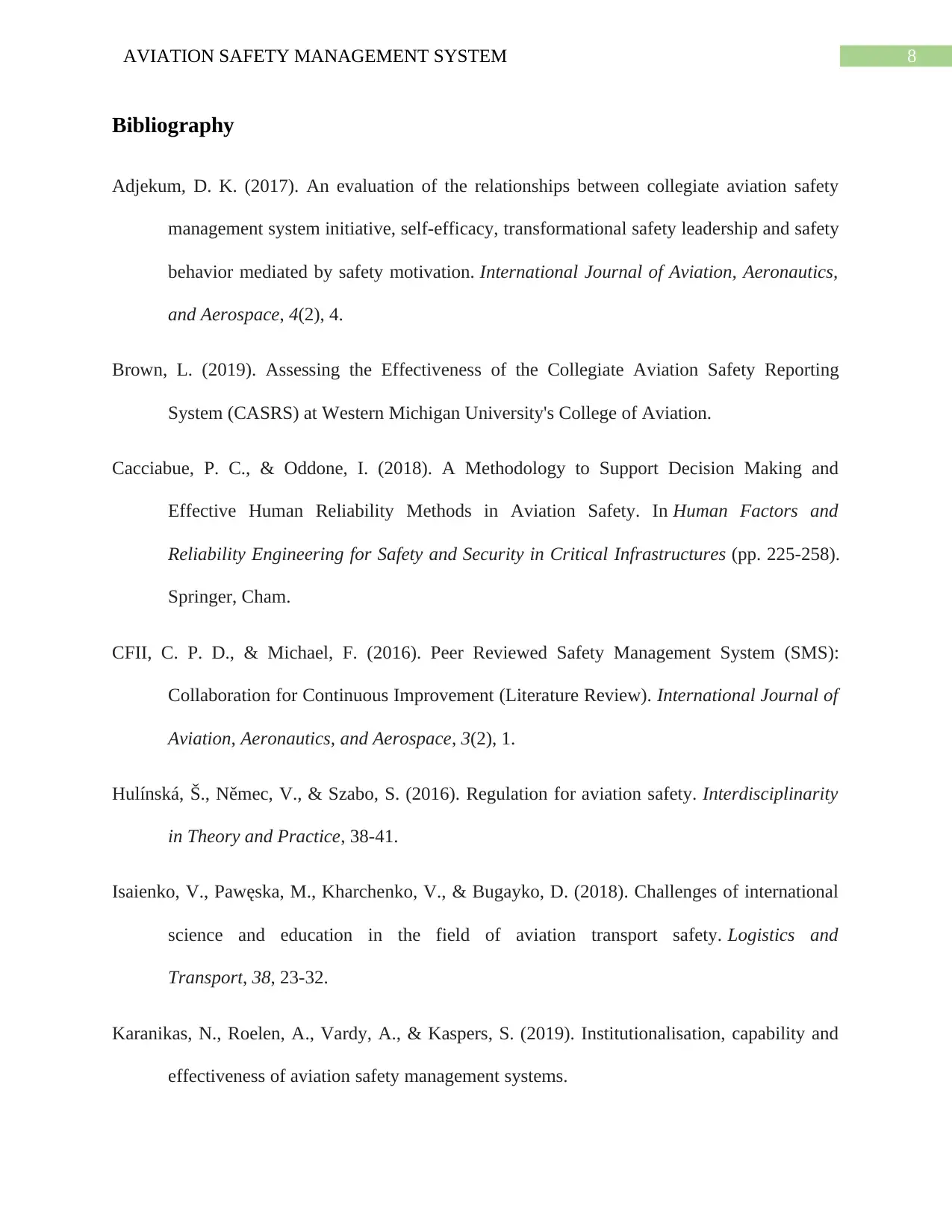
8AVIATION SAFETY MANAGEMENT SYSTEM
Bibliography
Adjekum, D. K. (2017). An evaluation of the relationships between collegiate aviation safety
management system initiative, self-efficacy, transformational safety leadership and safety
behavior mediated by safety motivation. International Journal of Aviation, Aeronautics,
and Aerospace, 4(2), 4.
Brown, L. (2019). Assessing the Effectiveness of the Collegiate Aviation Safety Reporting
System (CASRS) at Western Michigan University's College of Aviation.
Cacciabue, P. C., & Oddone, I. (2018). A Methodology to Support Decision Making and
Effective Human Reliability Methods in Aviation Safety. In Human Factors and
Reliability Engineering for Safety and Security in Critical Infrastructures (pp. 225-258).
Springer, Cham.
CFII, C. P. D., & Michael, F. (2016). Peer Reviewed Safety Management System (SMS):
Collaboration for Continuous Improvement (Literature Review). International Journal of
Aviation, Aeronautics, and Aerospace, 3(2), 1.
Hulínská, Š., Němec, V., & Szabo, S. (2016). Regulation for aviation safety. Interdisciplinarity
in Theory and Practice, 38-41.
Isaienko, V., Pawęska, M., Kharchenko, V., & Bugayko, D. (2018). Challenges of international
science and education in the field of aviation transport safety. Logistics and
Transport, 38, 23-32.
Karanikas, N., Roelen, A., Vardy, A., & Kaspers, S. (2019). Institutionalisation, capability and
effectiveness of aviation safety management systems.
Bibliography
Adjekum, D. K. (2017). An evaluation of the relationships between collegiate aviation safety
management system initiative, self-efficacy, transformational safety leadership and safety
behavior mediated by safety motivation. International Journal of Aviation, Aeronautics,
and Aerospace, 4(2), 4.
Brown, L. (2019). Assessing the Effectiveness of the Collegiate Aviation Safety Reporting
System (CASRS) at Western Michigan University's College of Aviation.
Cacciabue, P. C., & Oddone, I. (2018). A Methodology to Support Decision Making and
Effective Human Reliability Methods in Aviation Safety. In Human Factors and
Reliability Engineering for Safety and Security in Critical Infrastructures (pp. 225-258).
Springer, Cham.
CFII, C. P. D., & Michael, F. (2016). Peer Reviewed Safety Management System (SMS):
Collaboration for Continuous Improvement (Literature Review). International Journal of
Aviation, Aeronautics, and Aerospace, 3(2), 1.
Hulínská, Š., Němec, V., & Szabo, S. (2016). Regulation for aviation safety. Interdisciplinarity
in Theory and Practice, 38-41.
Isaienko, V., Pawęska, M., Kharchenko, V., & Bugayko, D. (2018). Challenges of international
science and education in the field of aviation transport safety. Logistics and
Transport, 38, 23-32.
Karanikas, N., Roelen, A., Vardy, A., & Kaspers, S. (2019). Institutionalisation, capability and
effectiveness of aviation safety management systems.
⊘ This is a preview!⊘
Do you want full access?
Subscribe today to unlock all pages.

Trusted by 1+ million students worldwide
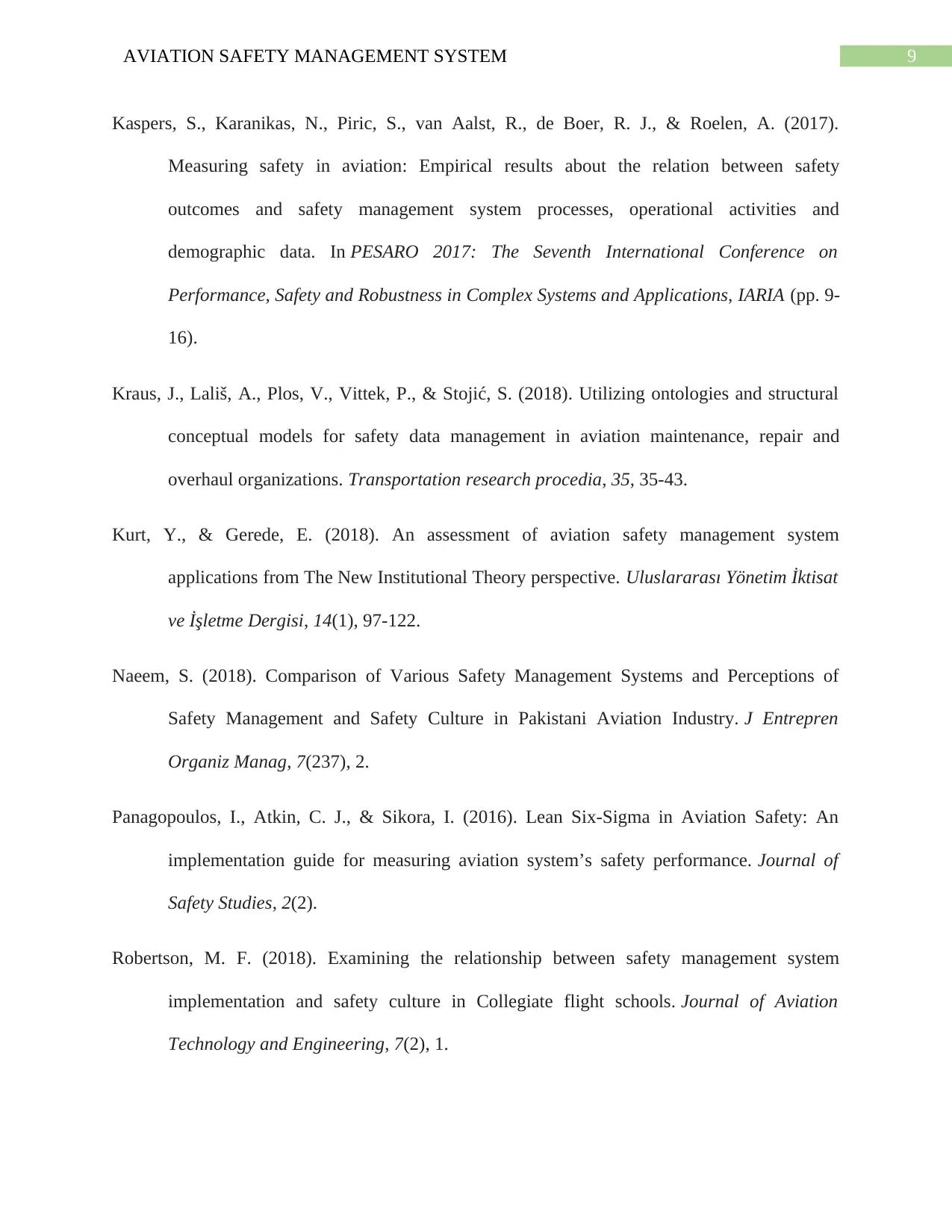
9AVIATION SAFETY MANAGEMENT SYSTEM
Kaspers, S., Karanikas, N., Piric, S., van Aalst, R., de Boer, R. J., & Roelen, A. (2017).
Measuring safety in aviation: Empirical results about the relation between safety
outcomes and safety management system processes, operational activities and
demographic data. In PESARO 2017: The Seventh International Conference on
Performance, Safety and Robustness in Complex Systems and Applications, IARIA (pp. 9-
16).
Kraus, J., Lališ, A., Plos, V., Vittek, P., & Stojić, S. (2018). Utilizing ontologies and structural
conceptual models for safety data management in aviation maintenance, repair and
overhaul organizations. Transportation research procedia, 35, 35-43.
Kurt, Y., & Gerede, E. (2018). An assessment of aviation safety management system
applications from The New Institutional Theory perspective. Uluslararası Yönetim İktisat
ve İşletme Dergisi, 14(1), 97-122.
Naeem, S. (2018). Comparison of Various Safety Management Systems and Perceptions of
Safety Management and Safety Culture in Pakistani Aviation Industry. J Entrepren
Organiz Manag, 7(237), 2.
Panagopoulos, I., Atkin, C. J., & Sikora, I. (2016). Lean Six-Sigma in Aviation Safety: An
implementation guide for measuring aviation system’s safety performance. Journal of
Safety Studies, 2(2).
Robertson, M. F. (2018). Examining the relationship between safety management system
implementation and safety culture in Collegiate flight schools. Journal of Aviation
Technology and Engineering, 7(2), 1.
Kaspers, S., Karanikas, N., Piric, S., van Aalst, R., de Boer, R. J., & Roelen, A. (2017).
Measuring safety in aviation: Empirical results about the relation between safety
outcomes and safety management system processes, operational activities and
demographic data. In PESARO 2017: The Seventh International Conference on
Performance, Safety and Robustness in Complex Systems and Applications, IARIA (pp. 9-
16).
Kraus, J., Lališ, A., Plos, V., Vittek, P., & Stojić, S. (2018). Utilizing ontologies and structural
conceptual models for safety data management in aviation maintenance, repair and
overhaul organizations. Transportation research procedia, 35, 35-43.
Kurt, Y., & Gerede, E. (2018). An assessment of aviation safety management system
applications from The New Institutional Theory perspective. Uluslararası Yönetim İktisat
ve İşletme Dergisi, 14(1), 97-122.
Naeem, S. (2018). Comparison of Various Safety Management Systems and Perceptions of
Safety Management and Safety Culture in Pakistani Aviation Industry. J Entrepren
Organiz Manag, 7(237), 2.
Panagopoulos, I., Atkin, C. J., & Sikora, I. (2016). Lean Six-Sigma in Aviation Safety: An
implementation guide for measuring aviation system’s safety performance. Journal of
Safety Studies, 2(2).
Robertson, M. F. (2018). Examining the relationship between safety management system
implementation and safety culture in Collegiate flight schools. Journal of Aviation
Technology and Engineering, 7(2), 1.
Paraphrase This Document
Need a fresh take? Get an instant paraphrase of this document with our AI Paraphraser
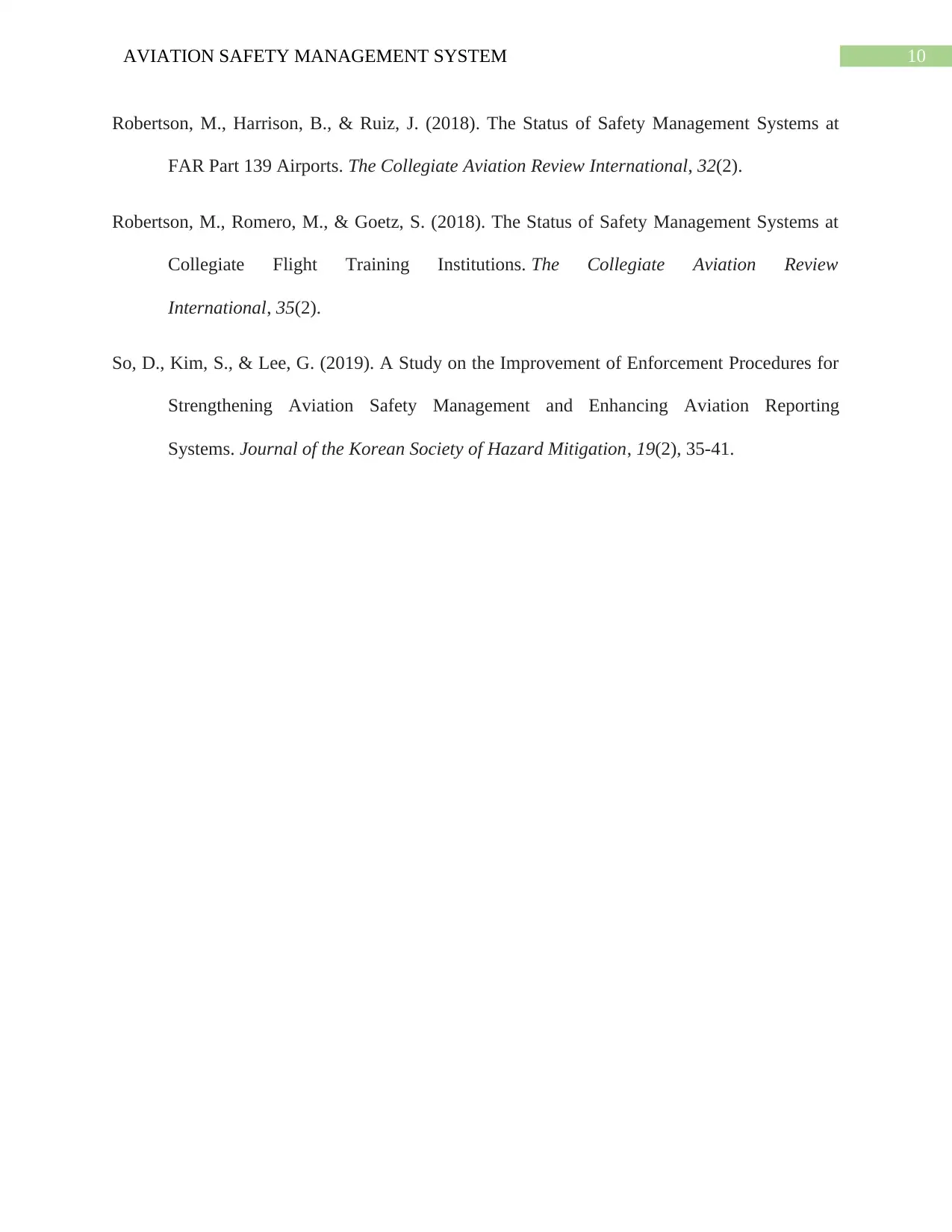
10AVIATION SAFETY MANAGEMENT SYSTEM
Robertson, M., Harrison, B., & Ruiz, J. (2018). The Status of Safety Management Systems at
FAR Part 139 Airports. The Collegiate Aviation Review International, 32(2).
Robertson, M., Romero, M., & Goetz, S. (2018). The Status of Safety Management Systems at
Collegiate Flight Training Institutions. The Collegiate Aviation Review
International, 35(2).
So, D., Kim, S., & Lee, G. (2019). A Study on the Improvement of Enforcement Procedures for
Strengthening Aviation Safety Management and Enhancing Aviation Reporting
Systems. Journal of the Korean Society of Hazard Mitigation, 19(2), 35-41.
Robertson, M., Harrison, B., & Ruiz, J. (2018). The Status of Safety Management Systems at
FAR Part 139 Airports. The Collegiate Aviation Review International, 32(2).
Robertson, M., Romero, M., & Goetz, S. (2018). The Status of Safety Management Systems at
Collegiate Flight Training Institutions. The Collegiate Aviation Review
International, 35(2).
So, D., Kim, S., & Lee, G. (2019). A Study on the Improvement of Enforcement Procedures for
Strengthening Aviation Safety Management and Enhancing Aviation Reporting
Systems. Journal of the Korean Society of Hazard Mitigation, 19(2), 35-41.
1 out of 11
Related Documents
Your All-in-One AI-Powered Toolkit for Academic Success.
+13062052269
info@desklib.com
Available 24*7 on WhatsApp / Email
![[object Object]](/_next/static/media/star-bottom.7253800d.svg)
Unlock your academic potential
Copyright © 2020–2025 A2Z Services. All Rights Reserved. Developed and managed by ZUCOL.




